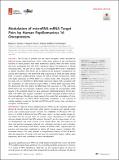| dc.contributor.author | Harden, Mallory E. | en_US |
| dc.contributor.author | Prasad, Nripesh | en_US |
| dc.contributor.author | Griffiths, Anthony | en_US |
| dc.contributor.author | Munger, Karl | en_US |
| dc.date.accessioned | 2017-02-18T01:59:04Z | |
| dc.date.issued | 2017 | en_US |
| dc.identifier.citation | Harden, Mallory E., Nripesh Prasad, Anthony Griffiths, and Karl Munger. 2017. “Modulation of microRNA-mRNA Target Pairs by Human Papillomavirus 16 Oncoproteins.” mBio 8 (1): e02170-16. doi:10.1128/mBio.02170-16. http://dx.doi.org/10.1128/mBio.02170-16. | en |
| dc.identifier.issn | 2150-7511 | en |
| dc.identifier.uri | http://nrs.harvard.edu/urn-3:HUL.InstRepos:30371110 | |
| dc.description.abstract | ABSTRACT The E6 and E7 proteins are the major oncogenic drivers encoded by high-risk human papillomaviruses (HPVs). While many aspects of the transforming activities of these proteins have been extensively studied, there are fewer studies that have investigated how HPV E6/E7 expression affects the expression of cellular noncoding RNAs. The goal of our study was to investigate HPV16 E6/E7 modulation of cellular microRNA (miR) levels and to determine the potential consequences for cellular gene expression. We performed deep sequencing of small and large cellular RNAs in primary undifferentiated cultures of human foreskin keratinocytes (HFKs) with stable expression of HPV16 E6/E7 or a control vector. After integration of the two data sets, we identified 51 differentially expressed cellular miRs associated with the modulation of 1,456 potential target mRNAs in HPV16 E6/E7-expressing HFKs. We discovered that the degree of differential miR expression in HFKs expressing HPV16 E6/E7 was not necessarily predictive of the number of corresponding mRNA targets or the potential impact on gene expression. Additional analyses of the identified miR-mRNA pairs suggest modulation of specific biological activities and biochemical pathways. Overall, our study supports the model that perturbation of cellular miR expression by HPV16 E6/E7 importantly contributes to the rewiring of cellular regulatory circuits by the high-risk HPV E6 and E7 proteins that contribute to oncogenic transformation. | en |
| dc.language.iso | en_US | en |
| dc.publisher | American Society for Microbiology | en |
| dc.relation.isversionof | doi:10.1128/mBio.02170-16 | en |
| dc.relation.hasversion | http://www.ncbi.nlm.nih.gov/pmc/articles/PMC5210503/pdf/ | en |
| dash.license | LAA | en_US |
| dc.title | Modulation of microRNA-mRNA Target Pairs by Human Papillomavirus 16 Oncoproteins | en |
| dc.type | Journal Article | en_US |
| dc.description.version | Version of Record | en |
| dc.relation.journal | mBio | en |
| dash.depositing.author | Harden, Mallory E. | en_US |
| dc.date.available | 2017-02-18T01:59:04Z | |
| dc.identifier.doi | 10.1128/mBio.02170-16 | * |
| dash.contributor.affiliated | Harden, Mallory E. | |


